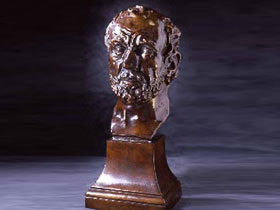In 1858, to help support his family Rodin began working commercially in the decorative arts. Urban Paris was in the throes of transformation; the Medieval city was making way for the Paris we know today. Statues and other ornamental sculptures were being erected in public places throughout the city, and artists were hired to work on these projects. For several years Rodin worked in the workshops of other artists during day and tried to fulfill his personal artistic ambitions by night.
Grief-stricken by the unexpected death of his sister in 1862, Rodin briefly joined a Catholic order. The founder of the order quickly realized monastic life was not Rodin’s true calling. He encouraged Auguste instead to make art, and it revived him. Ultimately Rodin was convinced to leave the monastery to pursue his dream of being a sculptor.
Once again supporting himself by working for decorative sculptors, Rodin rented his first studio, a small, cold, drafty stable. In the fall of 1863 he began a portrait bust that he intended to submit as his debut sculpture to the Paris Salon – the annual official public art exhibition. Acceptance to the Salon was very competitive. It could make or break an artist’s reputation because entry and its official prizes greatly influenced what was bought by collectors.
 For the first time, Rodin hired a model to sit for him. The model was not a professional, but rather a neighborhood handyman named Bibi. Rodin was drawn to his rough features and wanted to depict him as he was – broken nose, ugly, and all. His intended Head of the Man with the Broken Nose became Mask of the Man with the Broken Nose when the cold in Rodin’s studio froze the clay head he was modeling. The back of the head broke off, leaving just the face. Rodin, favoring the element of chance, accepted the head as a mask. He worked on it for over a year before submitting it to the Salon. Much to his disappointment, the Salon jury — all traditionalist seeking idealized portraits — rejected the work twice, in 1864 and 1865. Later in his career he said he considered the Mask of the Man with the Broken Nose to be his earliest major work and described it as the first exceptional piece of modeling he did.
For the first time, Rodin hired a model to sit for him. The model was not a professional, but rather a neighborhood handyman named Bibi. Rodin was drawn to his rough features and wanted to depict him as he was – broken nose, ugly, and all. His intended Head of the Man with the Broken Nose became Mask of the Man with the Broken Nose when the cold in Rodin’s studio froze the clay head he was modeling. The back of the head broke off, leaving just the face. Rodin, favoring the element of chance, accepted the head as a mask. He worked on it for over a year before submitting it to the Salon. Much to his disappointment, the Salon jury — all traditionalist seeking idealized portraits — rejected the work twice, in 1864 and 1865. Later in his career he said he considered the Mask of the Man with the Broken Nose to be his earliest major work and described it as the first exceptional piece of modeling he did.
During this time Rodin met Rose Beuret. She became his model and then his lifetime companion, remaining completely devoted to him. In 1866 she gave birth to their son, although Rodin never acknowledged legal paternity.